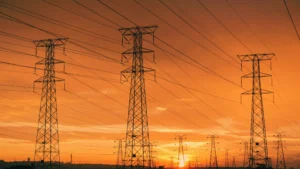Creating wildfire risk due diligence with AIP
The Texas Panhandle wildfires stand as the largest and most destructive fires the Lone Star state has seen to date. Though the initial cause remains unclear, Xcel Energy have confirmed the discovery of a fallen utility pole within the vicinity of the fire’s potential area of origin.
Xcel Energy officials stated:
“Xcel Energy has been cooperating with the investigations into the wildfires and has been conducting its own review. Based on currently available information, Xcel Energy acknowledges that its facilities appear to have been involved in an ignition of the Smokehouse Creek fire.”
In the statement, the utility also disputes any claims that they acted negligently in maintaining and operating their infrastructure.
This is the pattern electric utilities should expect every time a wildfire ignites. Utilities are levied with negligence allegations due to precedents set in several high-profile cases.
While affected communities have every right to seek restitution, a fallen pole sparking a wildfire does not necessarily equate to negligence. Wildfire risk mitigation is not a process of absolutes. High winds can knock a pole into a fuel source even when a utility has taken every possible measure to mitigate risk.
So, when an electric utility faces negligence accusations, how can they demonstrate they’ve done everything in their power to prevent such tragic losses?
A clear, transparent, and auditable capital investment plan is an invaluable asset in dismissing these allegations.
How capital is allocated to prevent wildfire
No matter how much we invest in risk mitigation, there will always be factors beyond our control. Strong winds in hot, dry conditions can undermine years of planning and effective risk mitigation in an instant.
Should that happen, it is the electric utility’s responsibility to demonstrate and educate how capital was allocated to mitigate wildfire risk.
Wildfire risk mitigation is a costly, labor-intensive, and continuous process, requiring a combination of investments which may include:
– Enhanced vegetation management
– Predictive maintenance
– Risk-based inspections
– Pole replacements
– Covered conductors
– Undergrounding
– Weather monitoring and forecasting
– Aerial surveillance
– IoT sensors
Each one of these investments has benefits as well as drawbacks. Variables like budget constraints, regulatory compliance, available labor, climate, and topography can all radically change both their effectiveness and feasibility.
How does an electric utility determine which combination of investments is the most effective? Is it merely an assumption based on present constraints? Or are there data-driven insights that support the strategy long-term?
Projecting the long-term benefits of a combination of investments is a challenge without the right tools. Which is why Asset Investment Planning solutions are a key component of effective risk mitigation.
Asset Investment Planning (AIP) is a software designed to enhance the long-term, strategic decision making of an organization. By ingesting and simulating asset performance long-term, AIP solutions can show both the impacts and trade-offs of different CAPEX and OPEX allocations. It does this while factoring in constraints like budgets, regulatory requirements, and risk tolerance.
Rather than relying on limited in-house solutions, historical data, and gut instinct, electric utilities that use AIP can see the entirety of their assets evolve through predictive modeling. This empowers utilities to proactively address challenges before they escalate.
AIP can be used for a range of practical applications. Anything from developing a sustainable growth strategy or leveraging the insights in a General Rate Case. And, as we’ve seen with several of our clients and partners, AIP is very useful when developing wildfire mitigation strategies.
Mitigating wildfire risk with Asset Investment Planning
When tasked with mitigating wildfire risk, electric utilities have options. But no single investment is perfect.
Undergrounding is highly effective, but expensive and slow. Standards like FAC-003-4 or G.O. 95 require vegetation management, but it’s labor intensive and full of operational challenges. Covered conductors can be a cost-effective, but can’t protect against prolonged contact with vegetation. Predictive maintenance can prolong asset lifecycles, but is the necessary data accurate and available?
Because each investment has pros and cons, the key is identifying the right balance between risk, spend, and efficiency. Maximizing the amount of risk reduced for every dollar spent. And this is where AIP becomes essential for wildfire risk mitigation.
Utilities that simulate the various “what if”-CAPEX allocations across the available options can get a much more accurate image of their risk-spend efficiency than those who limit their strategic planning to Excel. Seeing the long-term mitigation between various capital allocations for undergrounding, predictive maintenance, risk-based inspection, etc., enables an electric utility to act on reducing the maximum amount of risk for every dollar spent.
And with the risk holistically anticipated in an AIP, an electric utility can point to the funds allocated in the past, present, and future as proof they have done everything to mitigate wildfire risk. They can also show the investment strategies deemed less efficient, riskier, and costlier, further proving due diligence done.
Key features of AIP for wildfire mitigation
In general, AIP software enhances long-term strategic decision making by depicting the long-term evolution of asset against various CAPEX/OPEX allocations. However, not all AIPs are created equal.
When choosing an AIP solution to optimize creating and the allocation of wildfire risk mitigation measures, some key features the product must have include:
Data. The ability to capture extensive data from diverse formats, sources, or vendors, including financial, asset, IoT field sensor, weather, GIS, wildfire algorithms, market trends, and regulatory data.
Decision Trees. Integrating subjective elements like risk tolerance into an AIP with decision trees encapsulate the specific expertise and values within the organizations. For example, a utility can prioritize all maintenance activities based on an asset’s age, location, or material, ensuring all wood poles in a high-risk area receive inspections more frequently.
Visualization. Sharing insights generated from data, decision trees, and simulations with stakeholders from different disciplines through standardized dashboards, facilitating the flow of information and keeping silos from forming.
Transparency. Allow internal and external stakeholders to verify the asset models, decision trees, and simulation results to support that the selected strategy was the best available option.
The computational demands required for integrating all this disparate data, incorporating expertise, simulating long-term scenarios, visualizing outcomes, and allowing for validation across various stakeholders far surpass the capabilities of tools like Excel. Which is why AIP software can make a world of difference to ensure wildfire risk is mitigated with maximum efficiency.
Investing in your communities
Utilities spend an incredible amount of time and money agonizing over the smallest details to ensure the communities they serve receive safe and reliable power. But it’s impossible to reduce the risk to zero. They can make every right decision and bad luck can still befall a single asset at the wrong place, at the wrong time.
When the worst-case scenario does happen, as it did in the Texas Panhandle at the end of February 2024, how can you show that you’ve done everything within your control to prevent it?
Capital investment plans are typically seen as roadmaps for future strategic benchmarks. However, these roadmaps can just as easily be used to chart the progress and improvement year over year. When developed in Asset Investment Planning software, the multiple data-driven investment plans remain valuable even in hindsight.
An AIP solution that contains a myriad of possible investment scenarios, the answers to what ifs, and long-term projections of risk, asset degradation, and cost can be a key piece to ensuring the worst-case won’t happen again.



